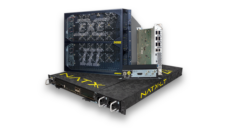
Core Issues
Oct 1, 2005 12:00 PM,
By Paul Mathews
What you need to know about distribution transformers.
What could be more mundane than the transformers and autoformers that are the backbone of audio distribution systems? This article will show you that there is a lot more going on with these chunks of iron and copper than you ever suspected. You will learn why transformers are often the power bottleneck in distribution systems, how to interpret datasheets, when to believe or disbelieve manufacturers’ claims, how to specify high-voltage components, and how to set up high-voltage systems to deliver the best possible power, fidelity, and bandwidth.
Toroidal types of transformers (right) tend to have lower leakage inductance and better high-frequency performance than most E-core models (left).
HIGH-VOLTAGE AUDIO DISTRIBUTION SYSTEMS
Although the term “constant voltage” is still in common use, I’ll use the less confusing “high voltage” (HV) terminology in this article. HV systems are in widespread use for these principal reasons. HV systems minimize power losses in low-cost wiring and facilitate connection of multiple loudspeakers without careful consideration of impedance matching. Also, once an individual power adjustment on a loudspeaker has been made, the loudspeaker continually receives the same amount of power even when other loudspeakers are added or removed from the system, resulting in more constant and uniform coverage. And finally, volume control by transformer tap at the loudspeaker end is more efficient than resistive pads.
TRANSFORMERS AT THE POWER AMP END: BOOSTING THE OUTPUT VOLTAGE
Solid-state power amplifiers usually need a voltage boost to get to the 70.7V and 100V levels of most HV systems, and a transformer or autoformer will do the job. The differences between transformers and autoformers will be covered later (see “To isolate or not to isolate?” on page 48). In the meantime, the term “transformer” will refer to both types. The transformer boosts the amplifier output by a fixed ratio, called its “turns ratio.” The correct transformer will provide the right amount of boost, which is simply the desired HV system voltage (70.7V, for example) divided by the amplifier full power output voltage.
Here is the basic procedure for selecting an output transformer for an HV system where the amplifier power required (P) has been determined using suitable methods:
To determine turns ratio to get proper HV level, begin by measuring the unclipped rms output voltage available from the power amplifier or calculate it from Ohm’s Law: Vout =√(P·R). For example, for an amplifier rated 100W at 8Ω, Vout = 28.3Vrms. Next, calculate desired voltage boost ratio (a.k.a. turns ratio), N = VHV / Vout. For example, N = 70.7 / 28.3 = 2.5. Select candidate transformers with a turns ratio within 20 percent of calculated N and with datasheet power ratings similar to amplifier output wattage.
In the next step, you will eliminate any candidate transformers that are likely to saturate. Most importantly, decide on the lowest system frequency (flc) for good fidelity and full power delivery. Then find datasheet ratings or conduct tests to determine voltage tolerance of candidate transformers at flc. To qualify, a transformer must not saturate when driven with Vout at flc. You may or may not be able to determine this characteristic from datasheets. Read on. Note that the low-frequency voltage capabilities of the transformer will be the primary limiting factor in system power delivery.

Figure 1: Primary voltage (yellow) and current (blue) oscilloscope traces for a distribution transformer entering saturation toward the end of each half cycle of input.
For a larger image, click here.
TURNS RATIO: FINDING IT ON THE DATASHEET
Turns ratio does not show up on many datasheets, but you can usually calculate it from other specifications. From the information on a transformer datasheet, find any combination of specifications that relates primary voltage (or primary power and impedance) to secondary voltage. Use these variations of Ohm’s Law to calculate the missing specification:
VPA = √P·R VHV = N·VPA N = VHV/VPA
For example, from transformer datasheet specs showing 300W at 4Ω (amplifier/primary side) and 70.7V output (secondary), use the first equation to calculate power amp output voltage VPA = 34.6V. Then, use the third equation to calculate N = 2.04.
Some transformers have what their datasheets call voltage taps. For example, a transformer might have 25V, 35V, and 45V primary taps, along with 70.7V and 100V secondary taps. For any combination of primary and secondary taps, the effective turns ratio is simply the ratio of the secondary tap value to the primary tap value, as given in the third equation above.
Now that we have the turns ratio (see above), let’s look at the other most important performance-determining characteristic, which is voltage capability, usually determined by transformer size and weight.

Figure 2: Amplifier voltage and current with an unloaded (open circuit) secondary.
For a larger image, click here.
SATURATION: WHAT’S ALL THE FLUX ABOUT?
Transformers have saturation problems that limit their capabilities at low frequencies. In fact, a transformer that is doing a great job at 100Hz can be an amplifier killer just an octave lower. What happens when a distribution transformer saturates? What does saturation sound like? Does this mean you have to high pass all your HV systems? These and other questions are answered below.
What does happen when a transformer saturates? Transformers transfer power from winding to winding by coupling through mutual magnetic fields. This transfer of power is amazingly efficient, and it happens with or without a core. However, the iron core plays two essential roles. First, the core contains the magnetic fields. Without a core, significant portions of the magnetic fields balloon out around the windings, reducing mutual coupling and potentially causing interference problems. Second, the magnetic field in the core itself opposes uncoupled current flow in the primary. This is why the transformer primary, even though it is made of heavy copper wire, does not normally act like a short. Note that without a core, the primary does act like a short, and a saturated core is not much better than no core.
Figure 1 on page 46 shows primary voltage (yellow) and current (blue) oscilloscope traces for a distribution transformer entering saturation toward the end of each half cycle of input. Both waveforms should be sinusoidal, but the spikes on the current waveform are due to saturation. Notice that the power amplifier, in this case, is still doing a good job of delivering a sine wave despite the current spikes. A less-robust power amplifier would show noticeable distortion coinciding with each spike. The coupling between primary and secondary is not much affected by core saturation. During saturation, however, the DC resistance of the primary suddenly appears in parallel. The power amplifier tries to maintain its output voltage, but the load impedance has taken a sudden dive.
Core saturation happens when the magnetic field in the core reaches its maximum possible density, which is what happens when the applied voltage polarity remains the same for too long. Bear in mind that saturation has nothing to do with power delivery; the onset of saturation depends only on the voltage waveform applied to the primary.
To reinforce this point, Figure 2 (on page 46) shows amplifier voltage and current with an unloaded (open circuit) secondary. The current waveform stays near zero until the volt-seconds limit of the primary is reached.
For audio signals, core saturation is more likely as you lower the frequency and raise the applied voltage. In Figure 2, the input was 20Vrms at 25Hz. The onset of saturation depends on voltage and time, so expect to see a similar problem for 40Vrms and 50Hz. Saturation voltage of a transformer rises linearly with frequency. This means that power handling capability declines with the inverse square of the frequency.
It should be no surprise that DC voltages are a serious problem for transformers, because DC is like zero frequency. Indeed, DC offsets of a few tens or hundreds of millivolts can asymmetrically saturate a transformer, meaning that saturation current spikes will occur primarily on one signal polarity. For this reason, some power amplifiers are a poor match to distribution transformers. This is also one reason why some manufacturers recommend installing resistors and capacitors in series with distribution transformers, further impacting low-frequency response. Well-designed power amplifiers have low offsets, and well-designed transformers tolerate a reasonable level of offset.

Figure 3: Actual test results for a 300W transformer with a specified frequency response of 20Hz to 20kHz. How would you rate its performance?
For a larger image, click here.
THE SOUND OF SATURATION
When power amplifiers are suddenly expected to deliver massive amounts of current, most will protect themselves by throttling back their output voltage. On the better amplifiers, Safe Operating Area (SOA) circuitry kicks in. On less well-designed units, the internal power supply voltages collapse, and the amplifier circuitry is then unable to deliver a faithful signal. Some amplifiers may blow fuses or simply fail. The sound that you hear depends very much on how a particular amplifier responds to this type of overload. Most likely, you will hear badly distorted bass and/or signal dropouts, but you may hear only the sound of silence.
Size matters. As with most things audio, you need larger components to handle lower frequencies, and the same is true for transformers. If other design elements are held constant, the larger cores can tolerate higher primary voltage levels because magnetic fields produce lower flux densities over their larger cross-sectional areas. Another way to improve the voltage capability of a transformer is to increase the number of turns in each winding. Adding turns usually results in either increased transformer size and cost, or additional insertion loss. Many of the distribution transformers I have tested would have much improved performance if their designers had simply added a few turns of wire to their design.
WHERE DOES IT SAY “SATURATION” ON THE DATASHEET?
Unfortunately, most transformer datasheets are not much help in providing specifications for low-frequency performance. Some provide a vague “frequency response” range. Fortunately, because no secondary load is required to observe saturation, bench measurements are easy. Connect a sine wave source to the primary with a small-value resistor in series. Measure the rms voltage across the primary with a voltmeter or an oscilloscope. Similarly measure the voltage across the resistor. Start at 1kHz and sweep downward. Across the resistor, you should measure a small voltage (proportional to primary current) that increases slowly as you decrease frequency. At some frequency, you will observe an abrupt increase in resistor voltage, indicative of the onset of saturation. Change the drive voltage and repeat the sweep. You should be able to derive a graph similar to Figure 3. This particular 300W transformer has a datasheet indicating “Frequency Response: 20Hz to 20kHz.” How would you rate it?
HIGH FREQUENCIES
From the discussion about low frequencies and saturation, you have probably guessed that saturation is not a problem at high frequencies. Other non-ideal characteristics, however, come into play. Stray magnetic fields, uncoupled between primary and secondary, show up as leakage inductance in series with the windings. Leakage inductance reduces the voltage available to the load at higher frequencies. Core losses are another phenomenon affecting high frequencies. The better cores use more expensive steels and thinner laminations. Datasheet specifications are reasonably reliable indicators of high-frequency performance.
Toroidal types of transformers (at right in the article’s opening image) tend to have lower leakage inductance and better high-frequency performance than most E-core models (at left in the same image). Excellent performance is available from either type of core; it all depends on the details of the design.
INSERTION LOSS
Insertion loss seems to be a mandatory specification for distribution transformers, although I find it difficult to understand why. Losses in loudspeakers themselves totally dominate most audio systems, and audio power is easy to find and cheap to buy. It is almost impossible to overheat even very lossy distribution transformers with audio program material. There is just too much iron, copper, and surface area in a transformer that is large enough to couple at low frequencies, and average audio power is so much lower than the peaks that the transformer must accommodate. Finally, the winding resistance that causes insertion loss can be a desirable feature because it improves the transformer’s tolerance for DC offsets. Ultimately, insertion loss is not a useful distribution transformer specification. Instead, focus on each transformer’s ability to deliver power at the highest and lowest required frequencies.
TRANSFORMERS AT THE LOUDSPEAKER END
On the secondary side of the power amplifier distribution transformer, we connect HV loudspeakers in parallel (each with its own step-down transformer) and adjust power taps as required to achieve required loudness in each area. Systems designers usually specify HV loudspeakers with integral transformers, so you might suppose that the drivers and transformers are well matched, so why worry? It turns out that 10 little 10W transformers in parallel can be just as troublesome as one big 100W transformer. The transformer characteristics discussed above apply equally at the loudspeaker end.
LOUDSPEAKER STEP-DOWN TRANSFORMERS AND SATURATION
The transformers at the loudspeaker end are prone to saturation, just like their big cousins at the amplifier end. Imagine the effect of 10 or more transformers all reaching voltage saturation in parallel and at the same time. Moreover, because saturation depends only on voltage, each loudspeaker transformer should be able to withstand full HV voltage levels at the lowest system frequency, regardless of the amount of power allocated to it. This is why most HV loudspeaker modules include a series capacitor to reduce the likelihood of transformer saturation. Note, however, that these capacitors are perfectly suited to carrying saturation current spikes once those spikes begin to flow.
IMPEDANCE-MATCHING
For best results, adjust loudspeaker taps so that they sum to either the power amplifier output rating or to the power amplifier distribution transformer rating, whichever is smaller. This will present the proper rated load impedance to the power amplifier, allowing it to develop rated power, while minimizing saturation effects in the transformer at low frequencies.
In the event that additional loudspeakers are added or power tap settings are increased beyond the amplifier or transformer rating, load impedance for the power amplifier will go down proportionately. A smaller but still linear load impedance, however, is usually the preferred alternative to a highly nonlinear saturating transformer.
TO ISOLATE OR NOT TO ISOLATE
Distribution transformers are available in both autoformer (non-isolating) and transformer (isolating configurations), so you have the option of isolating the loudspeaker wiring from the amplifier wiring. There are at least a couple of reasons why you might want to do so.
The first reason is safety isolation. Distribution transformers can provide an additional barrier between lethal mains power potentials and accessible loudspeaker terminals. HV lines from isolating transformers have no potential relationship with respect to earth ground, so that shocks are unlikely except in the event of contact with both lines at once. Some electrical inspectors require that HV lines be isolated from power amplifier outputs.
The second reason: isolation to break ground loops. For the many types of audio equipment that have shielding potentials connected to safety ground, non-isolated HV loudspeaker lines occasionally provide a return path for ground loops with enormous extents. In this era of plastic loudspeaker enclosures, this is becoming increasingly rare.
SUMMARY
When selecting a distribution transformer at the power amplifier end, first select proper turns ratio to boost to HV system level and to present an acceptable impedance to the power amplifier. You may have to derive turns ratio from other specs. Next, select for adequate low-frequency voltage capability to prevent saturation for good low-frequency power transfer. You may have to make your own measurements here. Finally, verify sufficiently low leakage inductance and low core losses for good high-frequency power transfer. At this point, it is usually acceptable to use datasheet information.
For transformers at the loudspeaker end, note that these suffer from the same problems and can equally become the weak link in a system. They are also often matched to and included with loudspeaker modules, so be aware of inherent characteristics.
Also, note that with toroids versus E-cores, design details are more important than shape. And finally, note that transformer isolation can improve safety and eliminate ground loops.
Paul Mathewsis a senior research and development engineer for Rane. A more detailed version of this paper is available at the Rane website:www.rane.com/note159.html.










